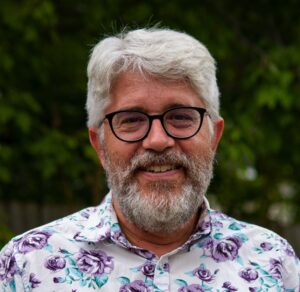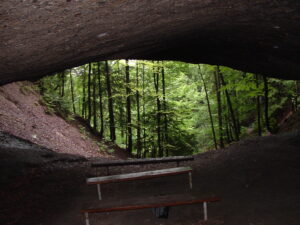Douglas Day Kaufman reflects on h0w trees have been part of Anabaptist worship since the beginning, and how caring for those trees is also part of our responsibility of caring for creation.
This post is in observance of Earth Day, April 22.
 Douglas Day Kaufman is the executive director of Anabaptist Climate Collaborative, which provides leadership training, amplifies diverse voices, and builds partnerships to equip and activate people to seek climate justice through Anabaptist values, community and faith. He served as a pastor for 30 years, most of that time at his home congregation, Benton Mennonite Church near Goshen, Indiana.
Douglas Day Kaufman is the executive director of Anabaptist Climate Collaborative, which provides leadership training, amplifies diverse voices, and builds partnerships to equip and activate people to seek climate justice through Anabaptist values, community and faith. He served as a pastor for 30 years, most of that time at his home congregation, Benton Mennonite Church near Goshen, Indiana.
______________________________
Some years ago, I spent a sabbatical in Switzerland, exploring Amish and Mennonite church history. While I spent a lot of time in churches, they were mostly the Reformed churches where my ancestors were baptized and married before becoming Anabaptists. When I wanted to spend time where Anabaptists worshipped, I went into forests.
Perhaps the best known early Anabaptist sanctuary is called the Tauferhohle, German for “Anabaptist Cave.” Another is the Geisskirchli, or the Chapel of the Goats, which includes a small inscription from Psalm 24: “The Earth is the Lord’s.” During a time of repression, when the most common form of persecution was deportation, this was their reminder that the earth belongs to God, not to the rulers of Switzerland.
These secluded locations helped Anabaptists avoid detection, but my sense is that a deeper connection developed between Anabaptists and forests. A Lutheran pastor once infiltrated an Anabaptist gathering in a forest. He wrote of them:
“The many lighted candles looked like wolves’ eyes shining among the trees and bushes on a dark night …
“During the preaching (lest I forget to mention it) some were standing, some were leaning against trees, many were seated, many lay on their sides, some lay face down, some were napping and some even sleeping …
“After these sermons, … Brother Peter admonished the brotherhood to prayer … Thereupon they scattered, all knelt, each usually before an oak tree as if he were worshipping it.”[1]

View looking out from Anabaptist Cave. Photo by Douglas Day Kaufman.
The pastor writes this way to undermine the Anabaptists, but this tells us that Anabaptists found meaningful ways to worship among the trees, even including the trees.
Many of us have felt the presence of the Spirit in the midst of the forest. When I pastored in a Mennonite congregation in Lancaster, Pennsylvania, many hunters would miss the Sunday before the start of the season. And some would assure me that they still experienced a form of worship.
I have felt the presence of the Spirit on hikes and walks in the woods. This is like the presence I have felt in church buildings, when singing a certain song, or when a preacher says a few words that brings a vivid memory or emotion to my heart.
I reflect on trees, because a major driver of climate change is deforestation. Trees store carbon. As many of us learned long ago, in elementary biology, they and all plants inhale carbon dioxide and exhale oxygen. Trees absorb other air pollutants, such as ozone, nitrogen dioxide, sulfur dioxide and particulate pollution. Fewer trees mean more pollution and more climate change.
Neighborhoods with trees are more pleasant. Vehicles slow down, people feel a greater sense of pride. Trees even reduce mental fatigue and improve production. They prevent flooding. In my northern climate, deciduous trees provide shade during hot summers and then, with their naked branches, the sun can shine through in the cold winters.
But some people in the U.S. have not had the same access to trees and forests. Redlining was the practice of keeping Black people in certain neighborhoods, through limiting access to mortgages. Many of these redlined neighborhoods also experienced ecological harms, such as being more prone to flooding, having environmental hazard sites close to them and even having fewer trees.
One part of the Inflation Reduction Act that was close to my heart was the Urban and Community Forestry program, which focused on planting trees in these neighborhoods. The cities of Goshen and Elkhart, in Indiana, had neighborhoods that qualified, and one of our partner organizations, Faith In Place, received grants to help congregations and other organizations in these neighborhoods plant trees. One such organization was Anabaptist Mennonite Biblical Seminary.
Though the money was already promised, this funding was frozen a few days into the current presidential administration. Faith In Place, whose executive director, Brian Sauder, is a Mennonite pastor on the board of Anabaptist Climate Collaborative, has joined an EarthJustice lawsuit against the administration. ACC has spoken to congressional members about our concerns that the promises to plant trees should not be broken, as well as advocating for preserving clean energy tax credits. You can join this campaign with our partner Mennonite Central Committee.
Planting trees in neighborhoods with fewer trees is a way to give more people the opportunity to connect with and enjoy trees. They provide both social and economic benefits to their human and more-than-human communities. It is a way of making more of the earth more livable again for humans, but also for birds and insects and other creatures.
May we come to the time prophesied by Isaiah, when we go out with joy and are led forth in peace, that the trees of the field will clap their hands.[2]
[1] Elisa Schad, “True Account of an Anabaptist Meeting at Night in a Forest and a Debate Held There with Them,” The Mennonite Quarterly Review (July 1984): 292.
[2] See Isaiah 55:12.

The views and opinions expressed in this blog belong to the author and are not intended to represent the views of the MC USA Executive Board or staff.

